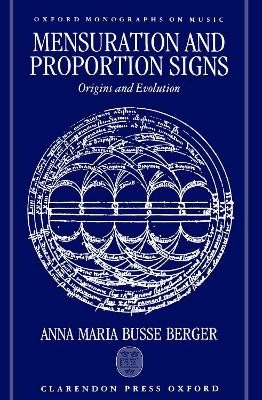
Mensuration and Proportion Signs
Oxford University Press Inc (Verlag)
978-0-19-760253-9 (ISBN)
In the fourteenth century composers and theorists invented mensuration and proportion signs that allowed them increased flexibility and precision in notating a wide range of rhythmic and metric relationships. The origin and interpretation of these signs is one of the least understood and most complex issues in music history. This study represents the first attempt to see the origin of musical mensuration and proportion signs in the context of other measuring systems of the fourteenth century. Berger analyzes the exact meaning of every mensuration and proportion sign in music and theory from the fourteenth to the sixteenth century, and offers revisions of many currently-held views concerning the significance and development of early time signatures.
Anna Maria Busse Berger is Distinguished Professor of Music, Emeritus, at the University of California, Davis. She has published articles and books on notation, mensuration and proportion signs, music and memory, mathematics and music, historiography, and music in African mission stations. She has won major awards from scholarly societies representing the three musicological disciplines: the American Musicological Society, the Society for Music Theory, and the Society for Ethnomusicology. Winner of the Alfred Einstein Award from the American Musicological Society (AMS) for best article by a young scholar, she has had fellowships at the Harvard University Center for Italian Renaissance Studies, Villa I Tatti, Florence (twice); the Guggenheim Foundation, the NEH, the Stanford Humanities Center, the University of Vienna, and the Institute of Advanced Studies (Wissenschaftskolleg) in Berlin. Her book Medieval Music and the Art of Memory won the ASCAP Deems Taylor Award and the Wallace Berry Award from the Society of Music Theory for 2006, and has been translated into Italian. Her article "Spreading the Gospel of Singbewegung: An Ethnomusicologist Missionary in Tanganyika of the 1930s" won both the Colin Slim Award for best article by a senior scholar from the AMS and the Bruno Nettl Prize from the Society for Ethnomusicology in 2014. She co-edited (together with Jesse Rodin) the Cambridge History of Fifteenth-Century Music (2015). In 2015, Busse Berger gave the Faculty Research Lecture at UC Davis, the Academic Senate's highest honor. In addition, she won the UC Davis Honors Teaching Award in 2019. In 2019, Busse Berger was made an Honorary Member of the AMS. She also received $210,000 from the Henry Luce Foundation together with her colleague Henry Spiller to research a Music History of Indonesia. Her most recent book is The Search for Medieval Music in Africa and Germany, 1891-1961: Scholars, Singers, Missionaries (2020).
Figures
Abbreviations
Introduction
1. The Representation and Interpretation of Mensuration Signs
2. The Origins of the Mensural System and Mensuration Signs
3. The Relationship between Perfect and Imperfect Time
4. The Relationship between Major and Minor Prolation
5. Diminution by Stroke and by Mode Signs
6. Proportion Signs
Conclusion
Appendix: Index of Signs
Bibliography
Index of Compositions
General Index
| Erscheinungsdatum | 08.11.2021 |
|---|---|
| Zusatzinfo | 5 line drawings, 5 halftones, 70 music examples |
| Verlagsort | New York |
| Sprache | englisch |
| Maße | 236 x 156 mm |
| Gewicht | 472 g |
| Themenwelt | Kunst / Musik / Theater ► Musik ► Klassik / Oper / Musical |
| Kunst / Musik / Theater ► Musik ► Musiktheorie / Musiklehre | |
| ISBN-10 | 0-19-760253-3 / 0197602533 |
| ISBN-13 | 978-0-19-760253-9 / 9780197602539 |
| Zustand | Neuware |
| Haben Sie eine Frage zum Produkt? |
aus dem Bereich


